We will explore the Locrian mode, break down some theory, give some sound examples, and let you decide whether you want to be crazy enough to try it out in your next song!
Before we jump into Locrian, let’s back up and discuss some basics first…
The topic of Music Theory is vast and complicated. It doesn’t have to be complicated and I’ve created a resource that goes through everything you need to know to be a competent musician, songwriter, and producer. I would highly recommend checking out that article as a primer to the rest of this article and other theory posts I have on this site. It’s titled “The Ultimate Guide on Music Theory for Musicians Who Dislike Theory.“
What Is a Mode?
Modes are a series of intervals (distance between notes) based on the notes of a musical scale. There are many types of modes beyond the seven based on the major scale.
For practicality and songwriting purposes, when we discuss modes, we talk about the major scale modes.
Modes are sometimes called church modes or greek modes, and each one has a distinct sonic vibe.
A mode can be used in melody and to build chord progressions when songwriting.
Using a mode can color your melody in exciting and fresh ways.
What Is the Locrian Mode?
The Locrian Mode is the darkest mode of the major scale.
Locrian is technically a minor mode because it has a minor third; however, its sound is a little more complicated than that.
The Locrian mode has more in common with a diminished scale rather than a minor scale.
In all other modes, there is a perfect fifth musical interval. This perfect fifth resolves to the first chord in a very pleasing way. It creates a strong sense of melodic resolution and satisfaction.
However, the Locrian Mode flattens the fifth scale degree and gets rid of the perfect fifth interval.
This lack of perfect fifth creates instability in melodies and a sense of no resolution to the listener.
The tonic chord in Locrian is also a diminished chord instead of a major or minor chord like all other modes. The diminished sound also contributes to the Locrian Mode having a dark, ugly, and unstable nature.
Diminished chords are considered a “passing chord” and would be used sparingly in chord theory.
Diminished chords generally want to resolve to the “one chord” or tonic. When this type of chord becomes your tonic, no melody or harmony will ever feel resolved.
In short: Locrian mode = Loads of Tension!
What Scale Degree Does the Locrian Mode Start On?
If you are playing modes of the major scale, the root note of the Locrian Mode would be on the seventh scale degree.
For example, in the C Major Scale (all white keys on a piano), if you counted up seven scale degrees from the tonic note of C, you would land on the note of B. If you began playing the same notes starting on B, you would be playing the B Locrian Mode.
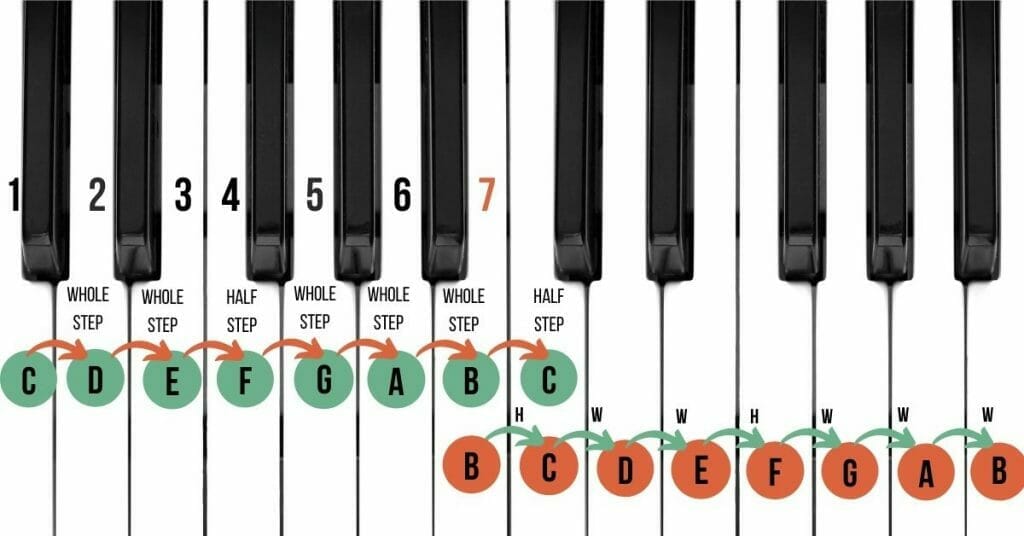
Locrian Mode vs. Locrian Scale
Technically a scale is not a mode. What defines a mode is the intervals between notes based on their related scale.
So saying it’s the Locrian Scale would be inaccurate.
My attitude, however, is that this shouldn’t matter.
Referring to modes as scales is a natural way for most people to understand the concepts.
Music theory is essential, and understanding it can help you make more informed decisions as a musician. Just don’t let the semantics trip you up from making music.
However, remember, if the “Locrian Scale feels right, it’s right.”
So instead of worrying if the Locrian mode is a Locrian scale, stop reading and experiment with it and see if you can find a place for it in your next song!
Is Locrian the Saddest Mode?
While Locrian is the darkest of all the modes, I wouldn’t consider it the saddest. Instead, the saddest probably belongs to Aeolian.
Locrian is the creepiest and most unsettling mode.
What Are the Locrian Mode Intervals?
The Locrian mode uses the same intervals (space between notes) no matter what key you play in.
Locrian intervals in relation to the Major Scale are:
| Interval | C Major Scale Notes | Interval | C Locrian Notes |
| C | C | ||
| Whole Step | D | Half Step | Db |
| Whole Step | E | Whole Step | Eb |
| Half Step | F | Whole Step | F |
| Whole Step | G | Half Step | Gb |
| Whole Step | A | Whole Step | Ab |
| Whole Step | B | Whole Step | Bb |
| Half Step | C | Whole Step | C |
Understanding the Major Scale is important for understanding modes. For more information on the Major Scale please refer to my article “The Major Scales: The Key to Great Songwriting.”
What Is the Sonic Vibe of Locrian Mode?
When you play a mode, you change the ordering of intervals (distance between notes) in the major scale. This gives different “colors” to the scale.
Songwriters often find it easy and intuitive to think of modes in terms of brightness and darkness.
Adding flats to the notes on a major scale can make the music sound more somber.
When you add sharps to the notes in the Major Scale, it can make the music sound more bright and other-worldly.
The Locrian Scale has five flats in it and, as we mentioned earlier, has very eerie, dark, and unsettling personality traits.
So is Locrian Viable for Pop Songwriting?
The simple answer for this is no. But it doesn’t mean that the Locrian Mode formula can’t be used to significant effect.
Imagine using the Locrian Mode for a song’s narration about a character who is in a scary situation. You could harness the Locrian sound to create a moment that “takes the breath” out of your listener in a surprising way.
This uneasiness can bring drama into your song.
However, this will be difficult to pull off in a musically pleasing way in a pop song context.
Remember, the Western world’s general public is used to hearing melodies that have a sense of resolution and “catchiness.” Unfortunately, the Locrian sound does not have either of these things and will sound displeasing to most listeners.
How Do You Play the Locrian Mode?
Now that we’ve touched on the basic music theory of the Locrian Mode, let’s look at how we can experiment with it in our playing and songwriting.
The Chords of Locrian
It’s one thing to hear the Locrian Scale note-by-note, but when you play chords and listen to how the harmonies stack upon one another, that’s when you start to see how the Locrian flavor can be used in your songwriting.
The following chart is only using the major, minor, and diminished chords of the major scale. You can play around with other types of chords (ie maj7 or min7) to give it more flavor.
| Chord Numeral | Chord Type |
| iº | Diminished |
| II | Major |
| iii | Minor |
| iv | Minor |
| V | Major |
| VI | Major |
| vii | Minor |
Guitar
Here is a graph of all the Minor CAGED position scales in G Locrian so you can practice Locrian when you write songs on guitar.
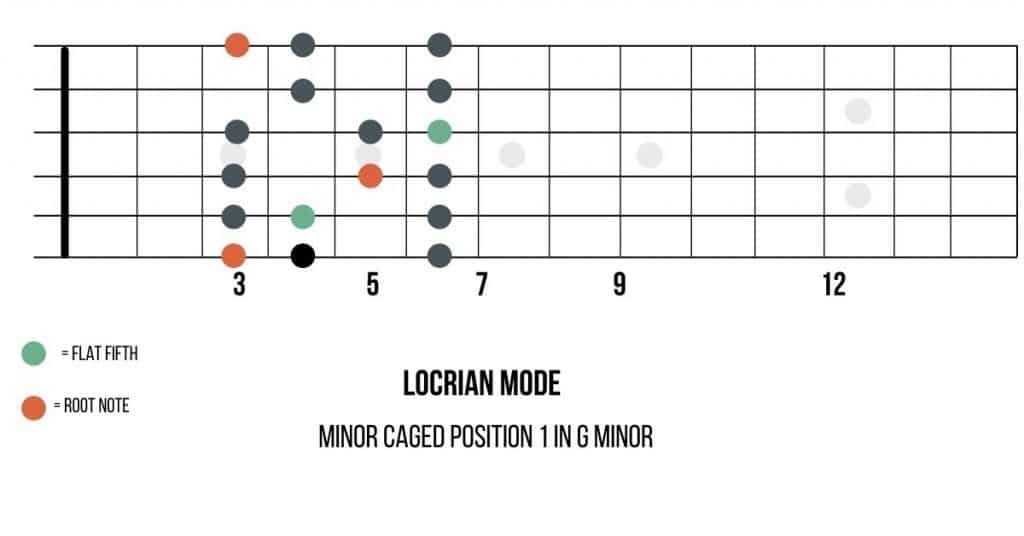

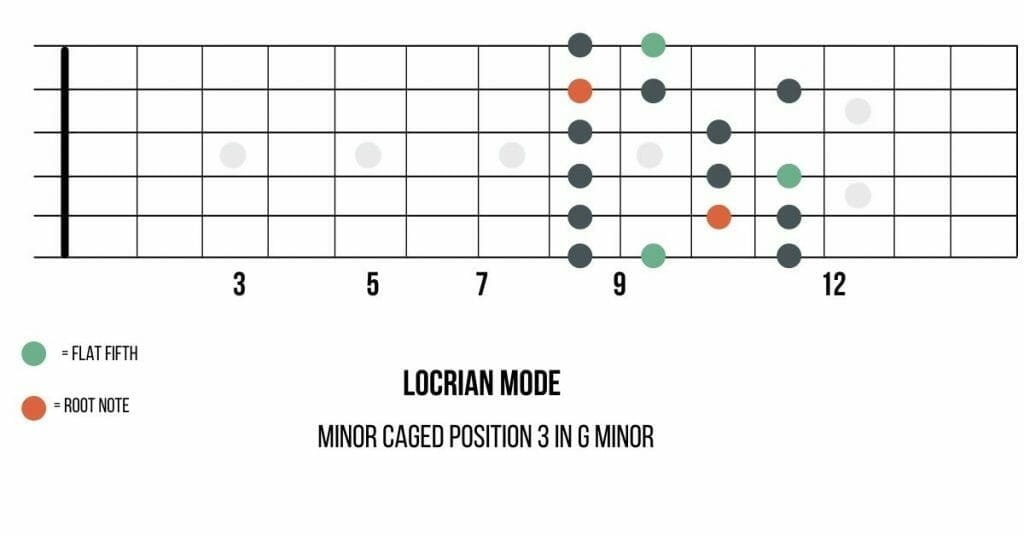
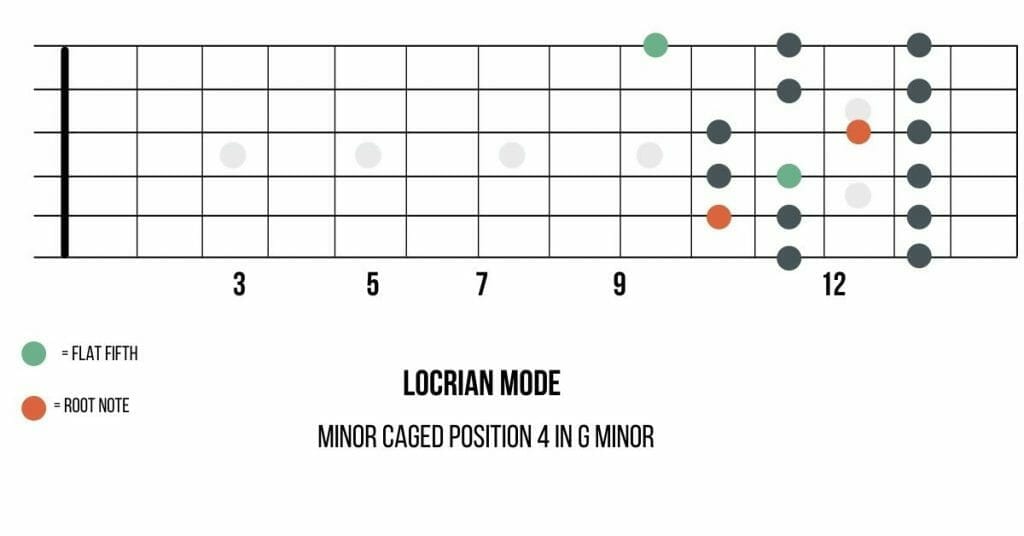
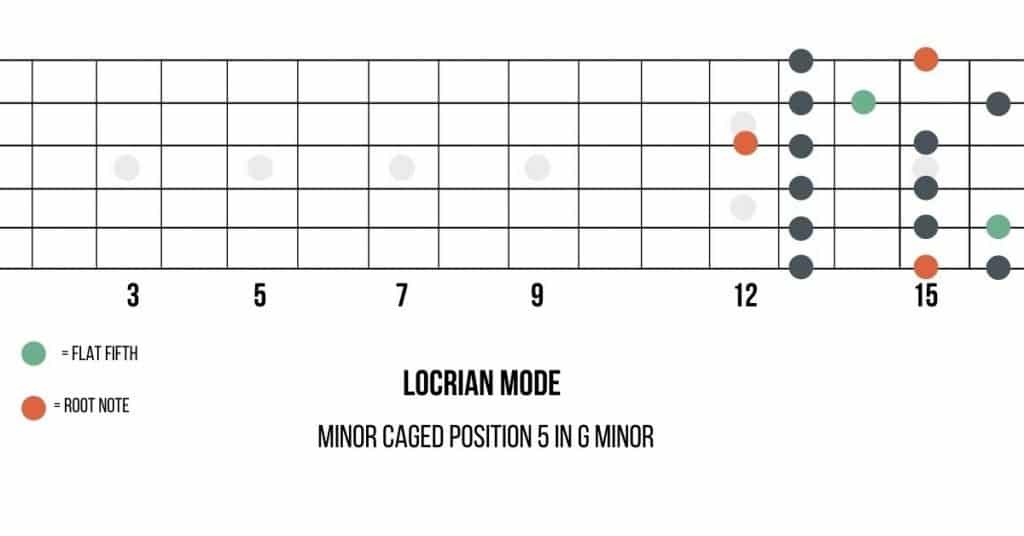
Using Locrian Scale for Songwriting
The Locrian mode is often found in jazz music and heavy metal music.
The Locrian Scale is often discussed as the “black sheep” of all the modes and is often overlooked in most songwriting circles.
However, this shouldn’t discourage you from trying your hand at adding in some Locrian tension into your songs.
You don’t have to play strictly in Locrian the entire song. Instead, you could weave elements of it into your songwriting.
I attempted something like this in the following example:
Another inspiring example of others trying to write songs in Locrian can be found in this great video by Adam Neely:
Chord Progressions for Locrian Flavor
Playing out the chord progressions in Locrian opens up more “pleasing” qualities to this mode. However, it is easy to modulate into different modes if you aren’t careful.
The biggest challenge with writing chord progressions that follow Locrian is that you will want to resolve the Diminished Root Chord to the Major Second Chord. However, if you do this, you essentially are playing the Ionian Mode (or major scale).
Also, it works better if you play around with the more jazzy maj7 of min7 chords within the progression, as they tend to be a bit softer and have less resolve. This seems to feel better when transitioning to the Diminished Root Chord of Locrian.
Locrian Mode and the Pentatonic Scale
The pentatonic scales could be described as a blues-rock musician’s bread and butter and is challenging to make sound bad.
There are both major pentatonic scales and minor pentatonic scales. Both major and minor pentatonic contain the same fives notes; they have a different root note (tonic).
To learn more about the Pentatonic Scale and how to use it for your songwriting, please check out my article “The Songwriters Guide to the Tasty Pentatonic Scale.”
So how do you use Locrian with Pentatonics?
This depends.
If you replace the fifth and second scale degrees with the flattened versions, you can create very exotic sounding scales. You will have to be careful with the chords you are riffing over, as they will easily clash.
It would be wise to add in the Locrian flavor when playing over diminished chords.
The Notes of Locrian Mode
Songs That Use Locrian
Bjork’s “Army of Me” – This song isn’t fully Locrian. Bjork’s vocals hit notes outside of the mode; however, the bass underneath this track sticks close to the Locrian Mode throughout. So again, listen for the unresolved tension.
The Strokes “Juicebox” intro bass is also Locrian, but the other melodies in the song steer away from being genuinely Locrian. Instead, this song is more Phrygian than Locrian.
What is the Super Locrian Scale?
This article focuses on the Locrian Mode as it relates to the major scale. However, you might hear the term Super Locrian Scale and wonder how to make this dark and eerie mode more “super.”
If you were to start on the seventh scale degree of the harmonic minor scale, you would be playing the Super Locrian Scale.
However, for the sake of writing popular music, you will never need to know this.
What To Do Next?
If you’re looking for a way to start your next songwriting session with an eerie edge, the Locrian Mode might be just what you need.
It’s the most unsettling of all the major modes in Western music theory. Nevertheless, Locrian can create some pretty dark sounds, which can sound great when used sparingly or as a bigger musical idea.
However, the Locrian scale will not be your best bet for writing songs that connect with people. Writing songs in this mode will primarily be an uphill battle.
I’d encourage most songwriters to stick with one of the other modes while crafting their melodies and harmonies. To get a complete overview of how modes can transform your music, check out my article “How Music Modes Enhance the Feeling In Your Song” today!

